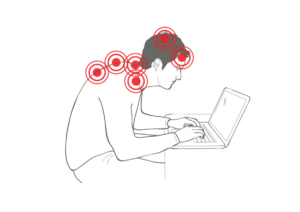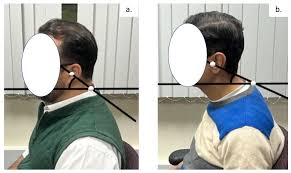

In our screen-saturated lives, neck strain has become the new normal. We swipe, scroll, and type for hours—often unaware of the toll this takes on our posture.
One of the most overlooked consequences of digital dependence is poor neck alignment, also known as “tech neck.” Over time, this small deviation from proper form snowballs into a full-body issue—impacting muscles, nerves, joints, and even mental focus.
This article unpacks exactly how bad neck posture worsens the effects of prolonged device use, why it happens, and what you can do to better support your spine in the digital age.
In this Article:
- Forward head posture from smartphone use
- The biomechanics behind device-related neck strain
- Neck pain associated with prolonged screen time
- Impact of digital devices on cervical spine health
- Children’s susceptibility to tech neck syndrome
- Effects of poor neck alignment on mental health
- Ergonomic solutions for tech neck prevention
- FAQs on Digital Devices and Neck Strain
- Posture correction tools for digital device users
- Conclusion: Resetting our relationship with screens
Forward Head Posture from Smartphone Use
Let’s start with what is arguably the root of the problem: the way we crane our heads forward to view screens.
The average human head weighs between 10 and 12 pounds in a neutral position. When you tilt your head just 15 degrees forward—common when texting—that weight more than doubles in pressure on the cervical spine.
By 60 degrees, you are putting up to 60 pounds of stress on your neck. This repeated forward tilt—typical when checking phones in laps or slouched at desks—causes the muscles, ligaments, and discs in the neck to work overtime.
Over months or years, this leads to muscular imbalances, early degeneration of discs, and sometimes even nerve compression.
The Biomechanics Behind Device Related Neck Strain
When the head shifts forward, the cervical spine compensates by changing its curvature, which has a domino effect on the rest of the body.
The upper back stiffens, the shoulders round forward, and the thoracic spine develops exaggerated kyphosis. To maintain visual focus and balance, the lumbar spine may also adjust by flattening or increasing its lordotic curve.
These changes are not just cosmetic—they alter the efficiency of how muscles fire and how load is distributed across your spine.
Over time, this distorted alignment increases the risk of tension headaches, TMJ dysfunction, shoulder impingement, and upper cross syndrome. All from looking down at a screen.
Neck Pain Associated with Prolonged Screen Time
Neck pain is now one of the most frequently reported musculoskeletal complaints in both office workers and teenagers.
According to a study published in the Journal of Family Medicine and Primary Care, nearly half of participants experienced neck pain linked directly to smartphone use.
Another study from the journal Heliyon revealed a direct association between smartphone addiction and postural changes in the neck.
Prolonged screen time does not just cause momentary stiffness—it rewires how your musculoskeletal system supports your head.
Left unchecked, this can contribute to chronic conditions like cervical radiculopathy, disc herniation, and even early onset arthritis in the neck joints.
Impact of Digital Devices on Cervical Spine Health
The cervical spine, made up of seven delicate vertebrae, was never designed for hours of sustained flexion. Digital devices demand repetitive and prolonged forward head motion, which changes the load-bearing characteristics of this region.
Over time, discs between cervical vertebrae can dehydrate and compress. Ligaments and tendons become overstretched, and joint spaces narrow.
These mechanical stressors can contribute to loss of cervical lordosis—a reversal of the natural C-shaped curve of the neck—which is commonly seen in people who spend too much time on screens.
This abnormal shape not only affects stability but can also compromise blood flow and neural signaling within the neck region.
Children’s Susceptibility to Tech Neck Syndrome
Children and adolescents are even more vulnerable than adults to developing forward head posture from device use.
Their musculoskeletal systems are still developing, and they are using tablets and phones for schoolwork, gaming, and socializing—often without any ergonomic guidance.
Research published in the International Journal of Environmental Research and Public Health found a significant correlation between screen time and altered head posture in school-aged children.
Because their bones and muscles are still growing, early postural misalignment can set the stage for lifelong structural issues. Schools and parents need to prioritize postural education just as they do literacy and nutrition.
Effects of Poor Neck Alignment on Mental Health
What is happening in your neck could be influencing your mood, concentration, and stress levels more than you think.
Chronic neck strain has been linked to psychological symptoms like anxiety, irritability, and even mild cognitive impairment.
Studies using functional MRI have shown that people with ongoing musculoskeletal pain—especially neck and upper back discomfort—often exhibit altered brain activity in regions related to emotional regulation.
Moreover, poor posture can restrict diaphragm movement, decreasing oxygen intake, which can further impair cognitive performance. Slouching is not just a physical burden—it can be a neurological and emotional one, too.
Ergonomic Solutions for Tech Neck Prevention
Preventing neck strain does not require giving up your devices—it just takes some biomechanical awareness. Here are a few ergonomic habits that can make a big difference:
- Raise your screen: Ensure your computer monitor or phone is at eye level. Use a stand if needed.
- Align your ears: Keep your ears stacked directly above your shoulders when seated or standing.
- Use voice-to-text: Reduce repetitive looking down by using dictation tools when possible.
- Take breaks: Every 30 minutes, stand up, stretch, and do a chin tuck to reset your alignment.
- Strengthen and mobilize: Add exercises like wall angels, rows, and cervical retractions to your routine.
These small changes can help offset the effects of digital device usage without disrupting your lifestyle.
Posture Correction Tools for Digital Device Users
Modern problems sometimes call for modern solutions. A variety of posture-correcting devices are now on the market that gently remind users to stay upright.
Wearables like the Upright Go 2 vibrate when you slouch, helping retrain your muscle memory throughout the day.
Ergonomic office chairs such as the Herman Miller Aeron are designed to support the spine’s natural curves, reducing the tendency to lean forward.
Phone and tablet stands elevate devices to eye level, helping to discourage downward gazing.
Even simple foam rollers or cervical traction pillows can help decompress the spine after a long day of sitting.
While these tools are not magic bullets, they are great sidekicks in the battle against tech neck.
FAQs on Digital Devices and Neck Strain
Q-1: Why does a small forward-neck tilt make phones and laptops feel “heavier” on my neck?
A-1: Tilting the head forward lengthens the lever arm between your head’s center of mass and your cervical joints. Even a 10–15° flexion can multiply the torque the neck must counter, so your 10–12 lb head effectively “weighs” much more to your muscles and discs. The steeper the tilt and the longer you hold it, the faster fatigue and stiffness build. Raising screens toward eye level shortens that lever and drops strain per minute.
Q-2: How does forward neck posture change my device behavior—even if I don’t feel pain yet?
A-2: Forward head posture nudges your eyes downward and closer to the screen, which encourages tighter viewing distances and longer glances. That creates a loop: closer viewing → more neck flexion → longer dwell times → higher load. You can break it by enlarging text, increasing viewing distance to about arm’s length, and parking the primary display roughly at eye height so your gaze—and neck—stay nearer neutral.
Q-3: Does forward neck posture affect breathing enough to worsen device-related strain?
A-3: Yes. A sustained slumped posture compresses the rib cage and reduces diaphragm excursion. Your body then recruits accessory neck muscles to help breathe, adding work to tissues that are already holding your head up. Short upright “breathing resets” (two slow exhales, rib expansion without shrugging) during device sessions unload those muscles and restore a more efficient breath pattern.
Q-4: What workstation clues tell me my setup is reinforcing a forward neck?
A-4: Watch for three cues: (1) the top of your monitor sits well below eye level, (2) you sit much closer than arm’s length to the screen, and (3) you crane your neck to look through the lower segment of progressive or bifocal lenses. Aim for the top bezel at or slightly below eye height, a primary viewing zone about 15–20° below horizontal gaze, and a viewing distance near arm’s length. Progressive-lens users often benefit from dropping the screen a bit to avoid neck extension.
Q-5: Why do brief posture breaks and small ergonomic tweaks beat willpower for “tech neck”?
A-5: Tweaks that change mechanics reduce strain automatically—no reminders needed. Raising screens reduces cervical torque every minute you work. Timed micro-breaks (once every 45–60 minutes) halt load accumulation before tissues get cranky: stand, two slow exhales, 10 chin nods, a 30-second chest stretch, then return to neutral gaze. Pair these with practical rules—hold phones at eye level, use stands for tablets, and avoid long downward glances—to shrink both total exposure and per-minute stress.
Bottom line: Forward neck posture magnifies device strain by boosting torque, shortening viewing distance, and even recruiting neck muscles for breathing. Eye-level screens, arm’s-length viewing, text-size tweaks, and scheduled micro-breaks turn down the load at its source.
Resetting Our Relationship with Screens
Bad neck posture is ot just a quirk of habit—it is a biomechanical strain that grows worse with every hour we spend on screens. What begins as minor neck tightness can evolve into structural changes, nerve compression, mood disturbances, and even long-term spinal degeneration.
But this is not a call to ditch your devices. It is a nudge to use them more wisely.
By becoming more aware of how posture affects our health, we can start making smarter choices—raising our screens, adjusting our seating, and taking short movement breaks.
Even teaching children early on to sit tall and hold devices at eye level can prevent lifelong issues. Whether you’re a student, a remote worker, or just a late-night scroller, better posture is one upgrade worth downloading.
So next time you feel the urge to slump, tilt your chin down to your chest, or scroll through your feed for “just five more minutes,” pause and lift your gaze. Your spine—and your sanity—will thank you.
References:

